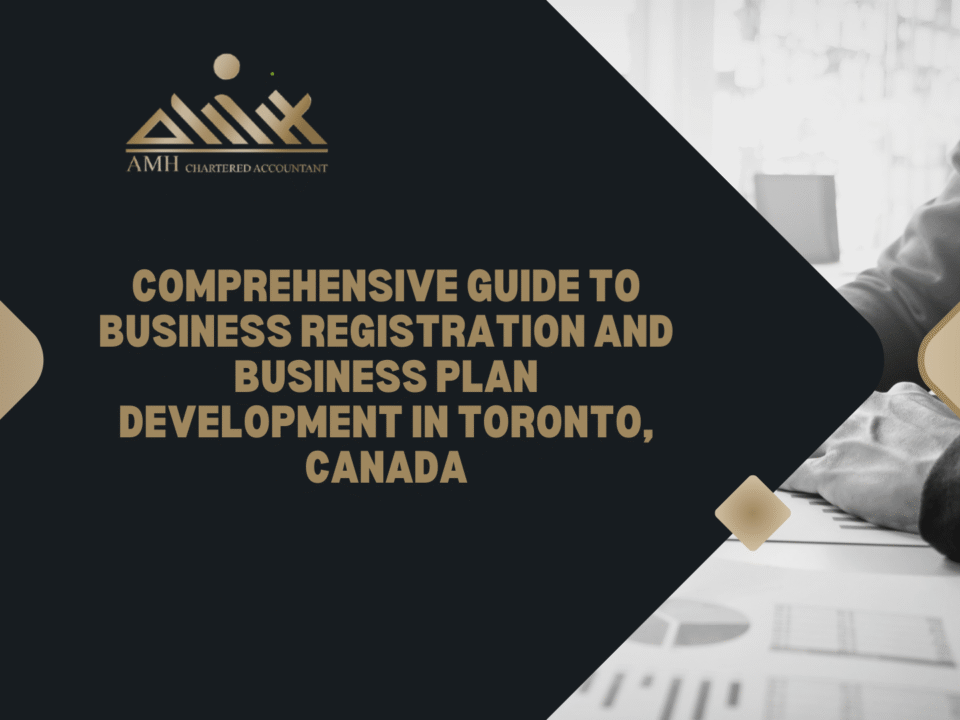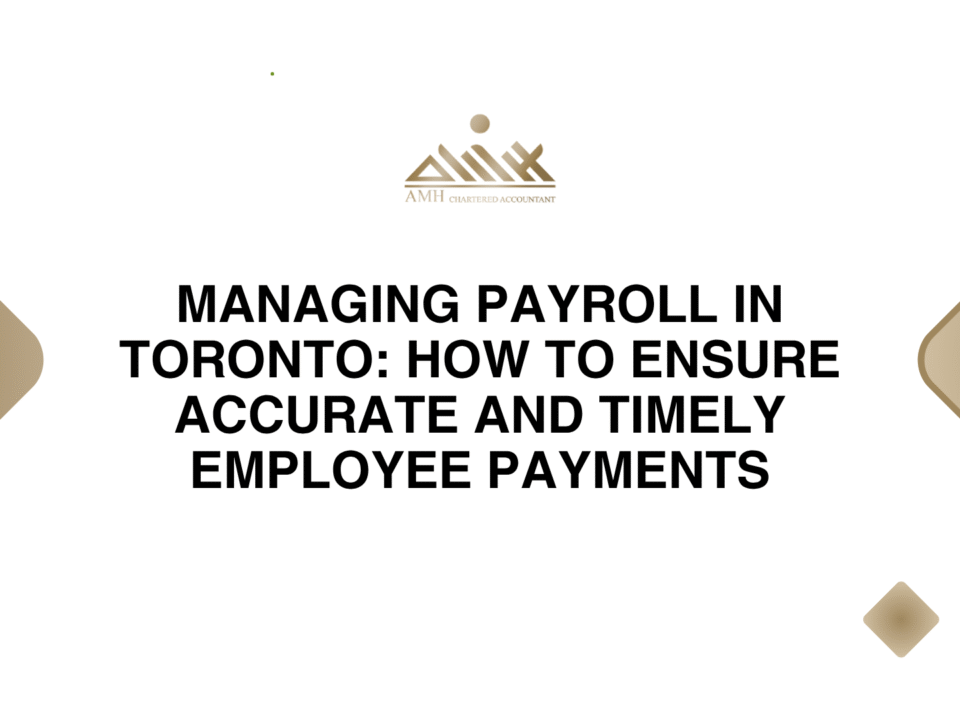
Annual Tax Planning Tips to Reduce Your Corporate Tax Bill
August 20, 2025
Cash Flow Statements: Why They Matter and How to Use Them
August 30, 2025How to Track and Analyze Overhead Costs Effectively
Overhead costs can be one of the most challenging aspects of running a business. They are essential to operations, but without careful management, they can eat into your profits. By effectively tracking and analyzing overhead costs, your business can optimize its expenses, improve profitability, and remain competitive. At AMH Chartered Professional Accountant, we specialize in helping businesses in Toronto, Milton, Oakville, Hamilton, Kitchener, and Waterloo track and analyze their overhead costs to enhance financial management.
Introduction: The Importance of Tracking and Analyzing Overhead Costs
Tracking and analyzing overhead costs is essential for businesses of all sizes. These costs, which are not directly tied to producing goods or services, can significantly impact a company’s profitability if not effectively managed. Overhead costs can include rent, utilities, salaries, and more, and they often accumulate quickly without immediate attention.
When overhead costs are too high, businesses may struggle to maintain profit margins, resulting in financial strain. Therefore, it’s important for business owners and managers to regularly monitor and analyze these costs, identify inefficiencies, and implement strategies to reduce them.
In this article, we will cover effective methods for tracking and analyzing your overhead costs, as well as strategies for managing these expenses and improving your financial performance.
What Are Overhead Costs?
Overhead costs refer to the expenses necessary to run your business that are not directly related to the production of goods or services. These costs are ongoing, and they generally remain constant regardless of the volume of goods or services your business produces.
Some common examples of overhead costs include:
Rent: The cost of leasing office or warehouse space.
Utilities: Electricity, water, heating, and other utility bills.
Salaries and Wages: Pay for employees not directly involved in production, such as office staff or management.
Office Supplies: Paper, pens, and other materials needed for daily operations.
Insurance: Business insurance premiums.
Depreciation: The reduction in value of physical assets over time.
Overhead costs are necessary for operations but do not directly contribute to generating revenue. Managing them effectively is key to optimizing profit margins.
The Different Types of Overhead Costs
Overhead costs can be categorized into several types, which help businesses track them more effectively. The two main categories are:
1. Fixed Overhead Costs
Fixed overhead costs remain constant regardless of production levels. These costs do not fluctuate with sales or production volume, and they are incurred even if the business is not generating revenue.
Examples include:
Rent or mortgage payments
Salaries for non-production staff
Insurance premiums
Depreciation of assets
2. Variable Overhead Costs
Variable overhead costs fluctuate depending on production levels or sales volume. These costs increase as production ramps up and decrease when production slows.
Examples include:
Utilities (e.g., electricity usage based on production hours)
Supplies (e.g., office supplies or packaging materials)
Shipping and delivery costs
Managing both fixed and variable overhead costs is critical to understanding your overall business expenses and optimizing profitability.
Why Tracking Overhead Costs Is Crucial for Business Success
Effective tracking of overhead costs provides several benefits for businesses:
Profit Margin Optimization: By reducing overhead costs, businesses can increase their profit margins without having to increase revenue.
Improved Cash Flow: Understanding overhead costs helps businesses plan for cash flow needs and avoid financial strain.
Competitive Advantage: Businesses that effectively manage their overhead costs can offer competitive pricing, invest more in innovation, and adapt quickly to market changes.
Cost Reduction: Regularly tracking overhead allows you to identify areas where you can cut unnecessary costs, improve efficiency, and streamline operations.
Without a solid understanding of your overhead costs, it’s difficult to accurately assess your business’s financial health, plan for growth, or make informed decisions.
Step 1: Categorizing Your Overhead Costs
To track and analyze overhead costs effectively, it’s important to categorize them into fixed and variable costs. This allows you to better understand the nature of each expense and how it impacts your business.
Fixed Costs: These are costs that don’t change with production or sales levels. They are predictable and should be accounted for in your regular financial planning.
Variable Costs: These costs fluctuate based on production or sales volume. Tracking them closely helps you understand how your operational costs change as you grow or scale back.
Categorizing overhead costs helps you better manage your expenses and prioritize which ones need immediate attention.
Step 2: Collecting Accurate Data on Overhead Expenses
Accurate data collection is critical for effective overhead cost tracking. To collect reliable data, you should:
Maintain Detailed Records: Ensure all invoices, receipts, and other documentation related to overhead costs are properly filed and categorized.
Use Accounting Software: Implement software like QuickBooks, Xero, or Sage to track overhead expenses automatically. These tools can generate reports that categorize costs and provide a clear overview of your expenses.
Update Regularly: Overhead costs should be updated regularly in your financial records, at least monthly, to ensure accuracy and up-to-date tracking.
Accurate and up-to-date data will help you identify areas where costs may be escalating, allowing you to take corrective action before problems grow.
Step 3: Using Accounting Software to Track Overhead Costs
Accounting software can significantly streamline the process of tracking and analyzing overhead costs. Here are some benefits of using accounting software:
Automation: Accounting software automatically tracks and categorizes overhead costs, saving time and reducing human error.
Customizable Reports: Most accounting software allows you to generate detailed reports that break down your overhead costs by category, department, or project.
Real-Time Monitoring: You can access up-to-date information on your overhead costs at any time, allowing you to make informed decisions quickly.
Popular accounting tools like QuickBooks and Xero offer features specifically designed to help businesses manage and analyze their overhead costs more effectively.
Step 4: Analyzing Overhead Costs: Identifying Areas for Reduction
Once you have collected accurate data, the next step is to analyze your overhead costs to identify potential areas for reduction. Here’s how to conduct a thorough analysis:
Review Trends: Look at how your overhead costs have changed over time. Are there any costs that have increased significantly without a corresponding increase in production or sales?
Identify Inefficiencies: Look for areas where resources are being underutilized. For example, are you paying for excess office space or utilities?
Benchmarking: Compare your overhead costs with industry standards. Are you spending more on overhead than similar-sized companies in your industry?
By identifying areas where you can cut costs or improve efficiency, you can take action to reduce your overhead and boost profitability.
Step 5: Benchmarking Overhead Costs Against Industry Standards
Benchmarking involves comparing your business’s overhead costs with those of similar businesses in your industry. This helps you understand whether your costs are in line with industry averages and identify areas where you may be overspending.
To benchmark effectively, research industry reports or seek guidance from industry associations or professionals, like AMH Chartered Professional Accountant. By comparing your overhead costs with competitors, you can identify potential savings and align your cost structure with industry best practices.
Step 6: Implementing Strategies to Reduce Overhead Costs
Once you’ve identified areas for improvement, it’s time to implement strategies to reduce your overhead costs. Some common cost-saving strategies include:
Outsourcing: Consider outsourcing certain tasks (e.g., payroll, IT, customer support) to save on employee salaries and benefits.
Negotiate Better Terms: Renegotiate contracts with suppliers or landlords to lower rent or purchase costs.
Energy Efficiency: Implement energy-saving measures, such as switching to LED lighting or optimizing heating and cooling systems.
Reduce Waste: Monitor and reduce waste in areas such as office supplies, packaging, or materials used in production.
By actively managing your overhead costs, you can maintain healthy profit margins and increase financial flexibility.
Common Mistakes in Overhead Cost Tracking and How to Avoid Them
Not Tracking Overhead Costs Regularly: Failing to monitor your overhead costs regularly can lead to financial surprises. Set up a routine to track these expenses monthly.
Lack of Categorization: Without proper categorization, it’s difficult to see where your money is going. Categorize your overhead costs into fixed and variable expenses for more accurate tracking.
Overlooking Small Costs: Even small overhead costs, like office supplies or subscriptions, can add up over time. Be sure to track all expenses, no matter how small.
Ignoring Cash Flow: Focusing only on cost reduction without considering cash flow can hurt your operations. Balance cost-cutting with maintaining liquidity for day-to-day operations.
How AMH Chartered Professional Accountant Can Help
At AMH Chartered Professional Accountant, we provide expert assistance in tracking and analyzing overhead costs to optimize your business’s financial performance. Our services include:
Overhead Cost Analysis: We review your financials to identify areas where overhead costs can be reduced.
Cost Management Strategy: We help you develop and implement strategies to manage overhead costs effectively.
Financial Planning: Our team provides ongoing financial planning services to ensure your business remains profitable and sustainable.
We understand the challenges of managing overhead costs and are committed to helping you navigate them for better financial health.
The Role of Financial Statements in Overhead Cost Analysis
Your financial statements, such as the income statement and cash flow statement, play a crucial role in tracking and analyzing overhead costs. These documents provide a comprehensive view of your expenses and can highlight areas where overhead is too high.
Regularly reviewing these statements allows you to make informed decisions about cost management and identify areas for improvement.
Technology and Tools for Streamlining Overhead Cost Management
In addition to accounting software, there are other tools available that can help you manage and track overhead costs, including:
Expense Management Tools: Use tools like Expensify or Zoho Expense to track and approve overhead expenses.
Project Management Tools: Platforms like Trello or Asana can help track operational costs associated with specific projects, allowing for better cost allocation.
By utilizing these tools, you can streamline your cost management processes and make data-driven decisions.
The Impact of Overhead Costs on Profitability and Cash Flow
Overhead costs directly impact both profitability and cash flow. High overhead costs can reduce profit margins, leading to lower net income. Additionally, if overhead costs are not well-managed, they can create cash flow challenges, especially during periods of slow revenue.
Effective overhead cost management ensures that your business remains profitable and financially healthy, with enough cash flow to invest in growth opportunities.
Conclusion: Mastering Overhead Cost Management for Business Success
Tracking and analyzing overhead costs is essential for running a successful business. By categorizing your overhead expenses, using accounting software, and implementing cost-reduction strategies, you can significantly improve profitability and financial stability.
At AMH Chartered Professional Accountant, we are dedicated to helping businesses in Toronto and the GTA optimize their overhead costs and achieve long-term financial success.
FAQs
What are the main categories of overhead costs?
Overhead costs are typically categorized into fixed (e.g., rent, salaries) and variable (e.g., utilities, supplies) costs.
How often should I track my overhead costs?
It’s best to track your overhead costs monthly to ensure accuracy and make timely adjustments when needed.
Can AMH help me with overhead cost management?
Yes, AMH Chartered Professional Accountant offers overhead cost analysis and cost management strategy services.
What tools can help me manage overhead costs?
Accounting software like QuickBooks or Xero, as well as expense management tools like Expensify, can help you manage and track overhead costs effectively.




